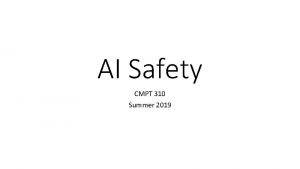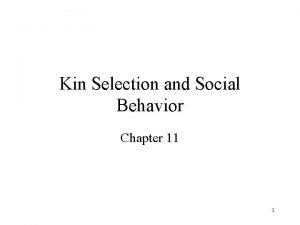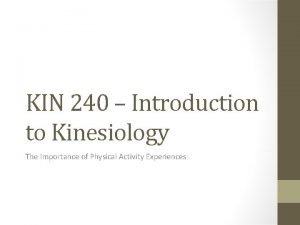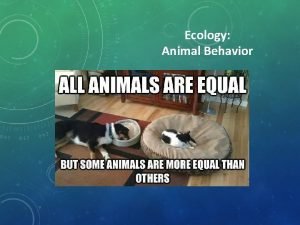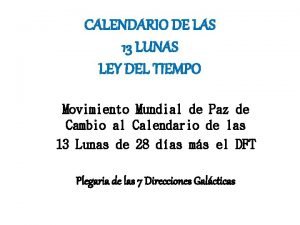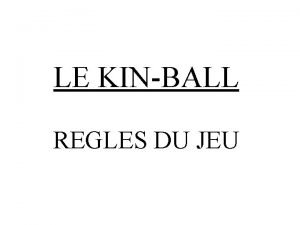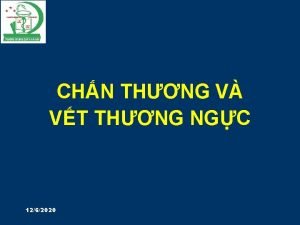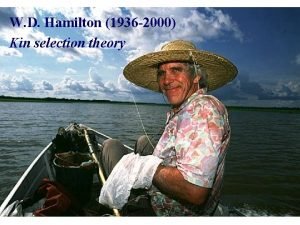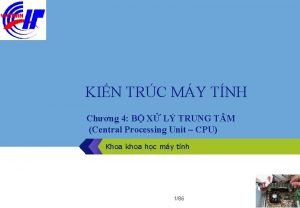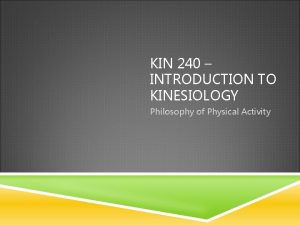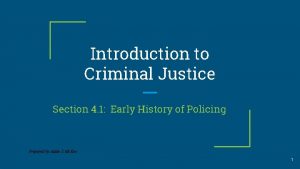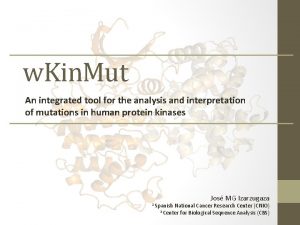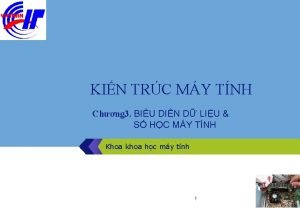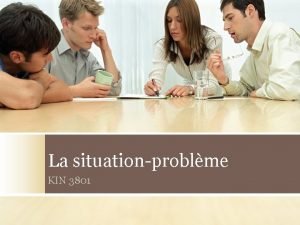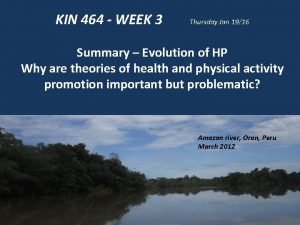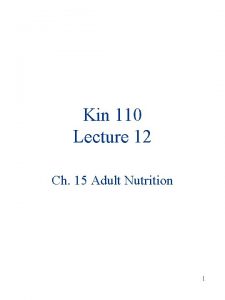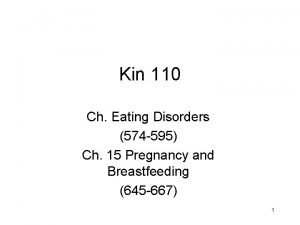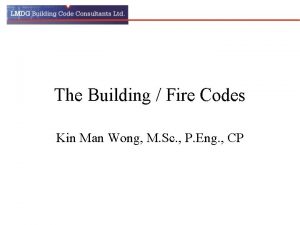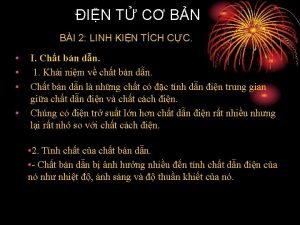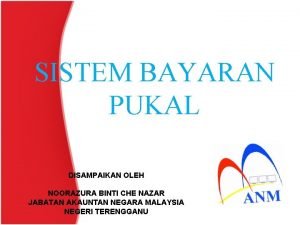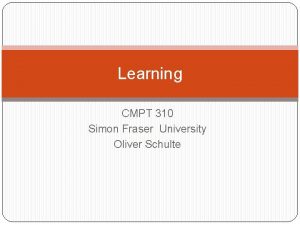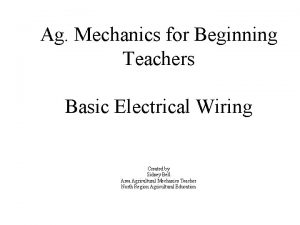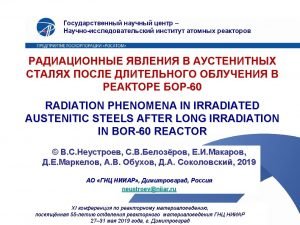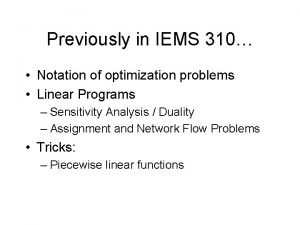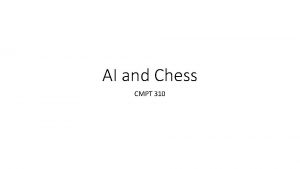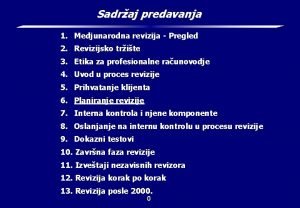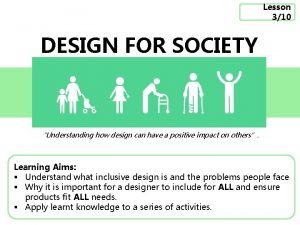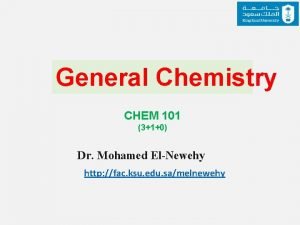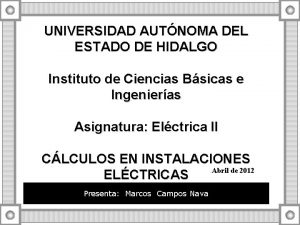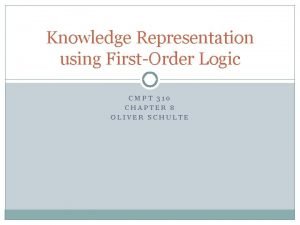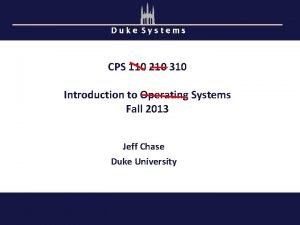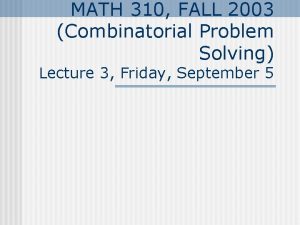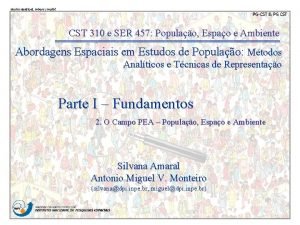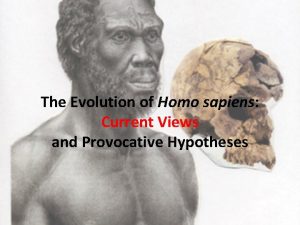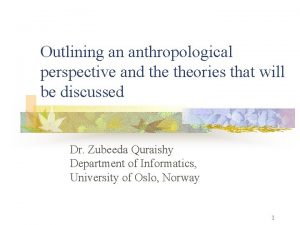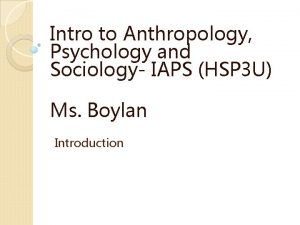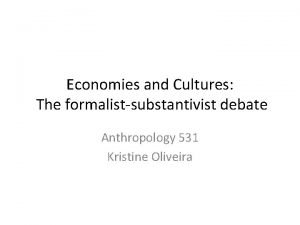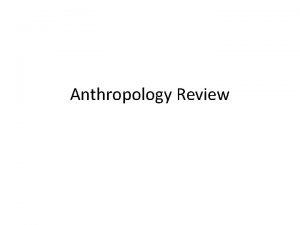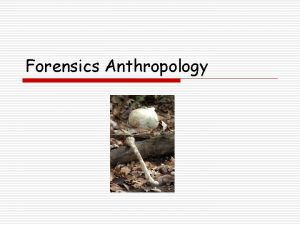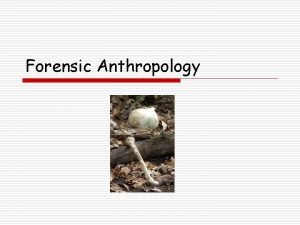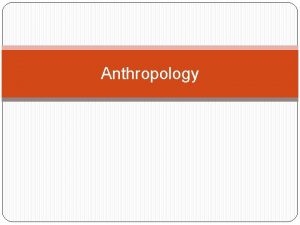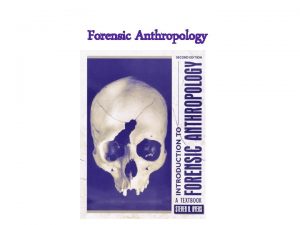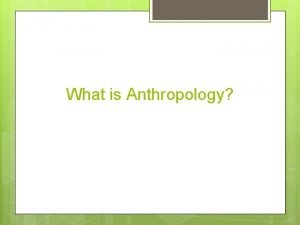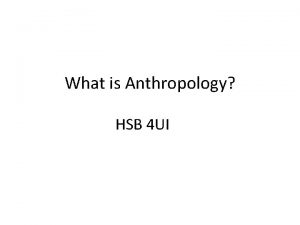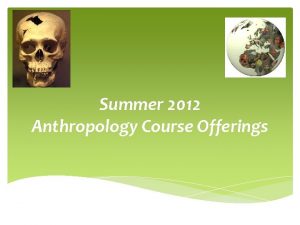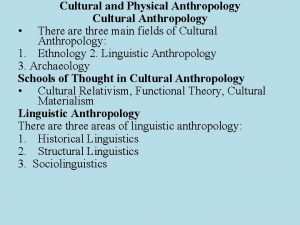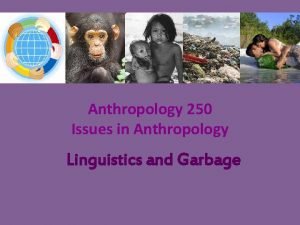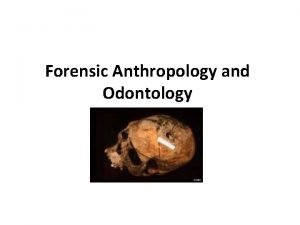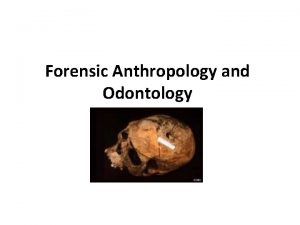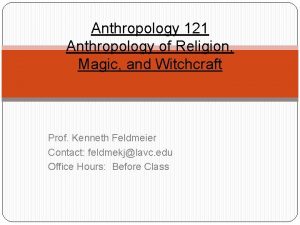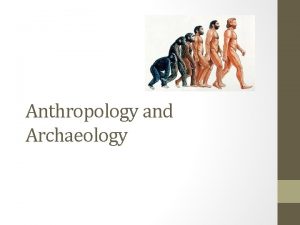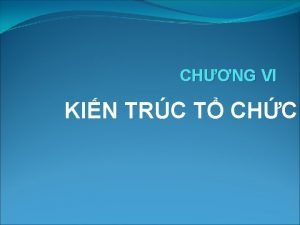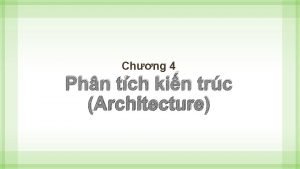Anthropology 310 Family Kin and Community Summer Session

































































- Slides: 65

Anthropology 310 Family, Kin and Community Summer Session 3 – 2008

Instructor • Christa Amouroux Hours: T&TH 9: 00 -1 pm. • Amouroux@sfsu. edu • Office: HSS 111 • Office Hours: 12: 30 -1: 15 Wed or by appointment.

“Anthropologists use relationships to uncover relationships” Marilyn Strathern 2005

Key Questions • What has happened to kinship studies since 1970? • How do we rethink fundamental questions and assumptions about familial connection? • What new possibilities and critical insights are offered by reproductive technologies? • What are the future of kinship studies and family forms?

Contemporary US Families • In 2008, less than half of the children in the United States will spend their entire childhood residing with both of their biological parents. • Divorce and remarriage, gay or lesbian parenting partnerships, single-parent families, adoptive and foster families are all forms of modern family life. • Reproductive technologies blur the conception of the nuclear-biological family even further with donor insemination, surrogacy and in-vitro fertilization becoming more commonplace.

Attendance • Three or more absences will result in failing or being dropped from the class. • Late arrival and early departure will also impact your grade significantly. • Please do not sign-up for this course unless you intend to read all the materials, participate in discussion and attend all class meetings.

Weekly Homework • During most class sessions you will bring a newspaper article, clipping from a magazine or other written media piece which relates to the readings assignment for the class session. • Be prepared to discuss how your article relates to the current class readings. • This easy assignment will help you make connections with what you are learning in class and the world around you. This assignment will also help you construct your final paper as that we will • discuss how to critically analyze concepts.

Quizzes • 4 quizzes will be given • Cover the week’s readings • Make-up quizzes will not be given.

Mid Term • • • 2 part mid-term: In-class section and a take home section available. In-Class Portion in class 7/31 The midterm will test your knowledge of the terms and ideas covered in class, films and in the readings. It is vital to keep notes on the terminology and main concepts covered in this course in order to successfully complete the in-class portion of the exam. Take Home Portion due 8/5 You will use two previously assigned readings for the take-home. The questions will ask you to place these readings in conversation with each other, and to summarize the main points and take a critical position. The take-home is 5 -6 pages in length.

Final Paper • Final paper 100 points- due in class on August 14, 7 -8 pages • Double-spaced, consisting of an analysis of reproductive technologies. • Please use the course readings, films and notes in your analysis.

Final Paper Guidelines • Locate media coverage on one new reproductive technology. You can use a case that is being or has been covered in the media or a story covered in the past five years. • Time, Newsweek and LEXIS/NEXIS, advertisements from the internet, websites for sperm banks or egg donors. • Your paper should focus on one issue such as prenatal testing, genetic screening, invitro-fertilization, surrogacy, or sex selection technology. • SIGN-UP FOR A TOPIC BY WEEK 2 • The summer session is short, so make sure to keep notes on how the assigned readings relate to your topic. It is essential that you use readings from the class in your analysis of the topic.

Texts • • Janet Carsten (2004) After Kinship Gerald Mallon (2004) Gay Men Choosing Parenthood Articles are available at http: //amouroux. wordpress. com/family-kincommunity-anthropology-310/ Copies are also available in SCI 3 rd Fl, Anthropology Department

Course Objectives • Develop a critical awareness of the meaning of the family and kinship as historically specific and socially constructed. • Develop critical reading and writing skills that allow for a nuanced understanding of issues related to the family, kinship and community. • Develop an understanding of a cross-cultural and transnational perspective of kinship, community and family.

Introduction to Kinship A Short History

What is Kinship? • “Kinship and marriage are about the basic facts of life. They are about 'birth, and conception, and death', the eternal round that seemed to depress the poet but which excites, among others, the anthropologist. [. . . ] Man is an animal, but he puts the basic facts of life to work for himself in ways that no other animal does or can” (Fox, 1996 [1967]: 27).

One Definition: Blood and Law • Kinship is the recognition of a relationship between persons based on descent or marriage. If the relationship between one person and another is considered by them to involve descent, the two are consanguines ("blood") relatives. If the relationship has been established through marriage, it is affinal. (Stone, 1997: 5).

One Definition: Relationships • The socially recognized relationship between people in a culture who are or are held to be biologically related or who are given the status of relatives by marriage, adoption, or other ritual. • Kinship is the broad-ranging term for all the relationships that people are born into or create later in life and that are considered binding in the eyes of their society.

Kinship: Network • Kinship is a system of social relationships that are expressed in a biological idiom, using terms like "mother", "son, " and so on. • It is best visualized as a mass of networks of relatedness, not two of which are identical, that radiate from each individual. Kinship is the basic organizing principle in small-scale societies like those of the Aborigines and provides a model for interpersonal behavior (Tonkinson, 1991: 57).

Working Definition: Kinship • Kinship encompasses the norms, roles, institutions and cognitive processes referring to all the social relationships that people are born into or create later in life, and that are expressed through, but not limited to, a biological idiom.

Cross Cultural Kinship • According to anthropologists, many cultures around the world use the word "family" differently. • To individuals in the United States there exists the concept of a nuclear family where a mother, father, and their children reside together while others consider all those people biologically related as "family. "

Cross Cultural Kinship • However, this is not cross-culturally valid. • Cultures such as the Fore and the Runa consider people who are not biologically related to themselves as members of their family. • Examples of these “fictive kin” are godparents or trading partners.

Kinship Charts • • • Triangle represents a man O represents a woman = denotes marriage Line represents connection between persons Triangle or circle with a diagonal line through it represents that the individual is dead • A diagonal line through the equal sign represents divorce.

Kinship Symbols Female Sibling link Male Adopted Cohabitation Either sex Deceased = Marriage = Divorce EGO Sexual relationship M or Mo = Mother F or Fa = Father Z or Si = Sister B or Br = Brother D or Da = Daughter S or So = Son W = Wife H = Husband Co = Cousin P or Pa = Parent Ch = Child Sib = Sibling

After Kinship Janet Carsten

Janet Carsten: After Kinship • What is the future of kinship studies? • How do new reproductive technologies impact our understanding of family, personhood and marriage? • What “new” familial arrangements are emerging? • How can anthropologists understand these changes?

Future of Kinship Studies • Rethink the biological family • Consider new family forms • Rethink the connections between kin, family and community. • How is childhood being changed? • What are the new definitions of parents? • Is marriage integral to family? Why?

Janet Carsten: After Kinship • Story of Stephen Blood and his wife’s desire to use his semen to conceive a child. • “I think I have the most right of anybody to my husband’s sperm and I desperately want this baby” Diane Blood • Rabbinic debates in Israel. What is the relationship between a sperm donor and a child? • What is the status of a child conceived this way? • Sperm donors must be taken from non-Jewish men.

Janet Carsten: After Kinship • Non-Jewish sperm does not affect the Jewish identity of the child since Jewishness in inherited from the mother. • Erasure of the father/sperm donor • Connection between family and the state

Janet Carsten: After Kinship • Anna: “I’m on a high. I’d just been out and I’d bought myself a new jumper. I thought I’ll wear my trouser suit and this new jumper to meet her. I had it all planned out- I didn’t want to look too dressy; I didn’t want to look too scruffy. I just wanted to look in-between, because I had this idea that she was quite poor…”

Three vignettes • These three stories are used by Carsten to demonstrate the new forms of kinship in the 21 st century: 1. Intense emotional experiences of family relations 2. Connection between private/public, legal/state and the process of nationmaking 3. Issues of personhood, gender and body

Janet Carsten: After Kinship • Is kinship a “pre-given” order of things? • Is it natural and unchangeable? • Anthropologists have focused on the social meaning of kinship, leaving the biological aspects tacit. • But is there a separation between biological and social kinship?

Janet Carsten: After Kinship • “Broken” and “reconstituted families” • Technological innovations- fertility treatment, genetic testing, posthumous conception, cloning, and the mapping of the human genome • Shake fundamental conceptions of familial connection • Is this a brave new world “after kinship? ”

History of Kinship • Mid-20 th century social anthropologists such as Malinowski, Radcliffe-Brown, Evans-Pritchard and Meyers Fortes kinship was the basis for understanding small-scale societies. • It was the structure in places that lack a state organization, or so it was thought. • Kinship was the political structure and the key to understanding these societies

Anthropology and Kinship • Virtually every major figure in American, British, and French anthropology felt compelled to consider kinship, sometimes briefly, but more often at considerable length. • J. F. Mc. Lennan (1970 [1865]) • Sir E. B. Tylor (1871, 1889) • Émile Durkheim and Marcel Mauss (1967), • W. H. R. Rivers (1900, 1906, 1907, 1910, 1914, 1915) • A. R. Radcliffe-Brown (1950, 1965 [1952]) • Bronislaw Malinowski (1913, 1929, 1930).

Western & Non-Western • “Kinship is something ‘they’ have; ‘we’ have families and this is quite a different matter” • In this tradition, language was seen as a direct reflection of culture and kinship terminologies were of interest because they revealed the way that language shaped social categories and hence behavior. • 1970’s saw the “undoing” of kinship

History of Kinship • Nuclear family – universal social institution • Separated the politico-jural from the domestic • Politico-jural was the focus because it translated into the public roles held by men • Kinship was interesting to anthropologists because it explained how societies cohered, made decisions and reproduced social-political structures

History of Kinship • Early on kinship was defined by anthropologists as variable, but the assumption was that there was a large degree of universality and consistency of kinship patterns • Women were absent from anthropological accounts of kinship because the emphasis was a colonialist project of trying to understand the forms of decision-making among “tribes. ”

Lewis Henry Morgan • Lewis Henry Morgan, often spoken of appropriately as the father of American anthropology, called attention to the subject in his pioneering ethnographic contribution, League of the Iroquois (1969 [1851]: 83 -87). His Systems of Consanguinity and Affinity of the Human Family (1871) was the first systematic, cross-cultural analysis of kinship nomenclature.

Claude Lévi-Strauss • Elementary Structures of Kinship (1949, tr. 1962) -"Only kinship data present an internal logic comparable to the system of language. " Examined the "roots of the kinship problem" beginning with incest prohibition (the origins of culture- gift and counter gift realized by alliance) and the "principle of reciprocity" (wife exchange) and organized a large number of phenomena that had seemed disparate and obscure.

The Elementary Structures of Kinship • In The Elementary Structures of Kinship (1949), Lévi-Strauss argued (contra Radcliffe. Brown) that a cultural phenomenon such as unilateral cross-cousin marriage cannot be explained in terms of individual sentiments. • Following the lead of Mauss and Durkheim, he proposed that a rule directing men to marry their matrilateral cross-cousins is, for structural reasons, more productive of social solidarity than the reverse.

Claude Lévi-Strauss Elementary Structures of Kinship (1949) • His work on kinship contained complex theorizing on the long-term structural implications of particular types of marriage alliance • “Positive Marriage Rules” • These were “elementary” rules which he contrasted with “complex” rules/systems • Because there was no injunction to marry a specific kin member ( i. e. , elementary) only “negative marriage rules” (who not to marry)

Claude Lévi-Strauss • Levi-Strauss structuralism uses decontextualized ethnographic evidence and asserts all humans think in binary oppositions and that myths express and resolve dichotomies within society. • Myths are symbolic systems which reconcile fundamental human dilemmas and inherent contradictions between self and other, nature and culture, life and death. • As an arm chair anthropologist Levi-Strauss sought to identify patterns among wide range of "primitive" myths.

Claude Lévi-Strauss • For Levi-Strauss simple societies were ruled by kinship structures, primarily wife exchange • He underlined the centrality of marriage in kinship, that was the institution that maintained relations among groups, not just individuals. • Marriage was an elaborate, long-term exchange that cemented relations and involved the exchange of goods, services and loyalties • Alliance and descent theory

David Schneider • 1969 A Critique of the Study of Kinship and American Kinship (1968) • Founded a new study in the field of kinship • Generation of cultural meanings was the central problem rather than the functioning of the social group or the comparative analysis of kinship terminologies • Move from function to meaning in anthropology

David Schneider • This concern for meaning signaled a shift in anthropology from function to meaning (Geertz & Weberian focus on meaning) • It was a departure from British-style studies that focused on social structure (Fortes, Radcliffe. Brown, Levi-Strauss) • He defined a new way of doing kinship

David Schneider • He discussed why kinship could no longer progress as it had. • Critique: the analytic domain that kinship occupied was unsound. • Anthropologists has used folk models from their Euro-American cultures • These models were in-valid cross-culturally • Euro-American models assume the primacy of ties derived from sexual procreation

David Schneider • These assumptions – procreation and family/kinship- did not necessarily apply crossculturally • His work problematizes the relationship between the biological and cultural in kinship • Assumed that Euro-American kinship was coherent and stable • Gender and feminist studies developed in response to Schneider’s critique

David Schneider • According to Carsten, “Schneider occupies a pivotal role in the reformulation of kinship studies in anthropology” • He focused on structure and functions of social groups and the meanings of kinship in a particular context • He was concerned with the generation of cultural meanings using language.

The natural order • When a person is related to a blood relative s/he is related first by common biogenetic heredity, a natural substance, and second, by a relationship, a pattern of behavior or a code of conduct (Cinderella) • Code of conduct – an expectation of behavior (legal) • Natural substance- genes (natural) • Nature trumps law

The Family • Family can mean “all relatives” but often refers to the nuclear family unit • Family is synonymous with relative (biological or legal) • Schneider defines family –assemblages of different kinds of relatives into a single cultural unit; this is quite different from “the simple plurality of relatives without regard for their kind or their relationship to each other” (fictive kin and families we choose) • Sexual intercourse: differentiates members of the family • Procreation/intercourse: is the symbol which provides the distinctive features in terms of the family as relative and the family as a cultural unit

The Family • The family is defined as “natural” in American culture and co-resident • Contains a wife, husband children (heteronormative) • A married couple without children, is not quite a family but a potential family • To be a family, you must live together • Single parent families are “not quite families”

The Family • A healthy family lives together • The family is formed “by the laws of nature and it lives by the rules which are regarded by Americans as self-evidently natural” • “The family…thus resolves the radical opposition between nature and human reason, brining these two together into a workable, livable, human arrangement” • Voluntary and involuntary relationships

The Family & Gender Roles • The family naturalizes and reinforces gender roles (ex. Bride Kidnapping film) • Reproduces gender identities • Maintains gender roles • Reinforces common sense knowledges • Husband wife are in a sexual relationship and theirs is the only legitimate (legally and culturally) and proper sexual relationship

Nuclear Family and other Myths • Historical studies suggest that the stable nuclear family of the mid 20 th century Britain or North America was a historical blip • 19 th century myth of the nuclear family, a product of bourgeois mentality • Late marriage, celibacy, pregnancy out of marriage were common in the Middle Ages to the 19 th century • High morality rates meant that marriage was a short-lived relationship • Parental death meant that children were also highly mobile

Common myths about the American family • The traditional family: breadwinner dad, homemaker mom • The nuclear family: dad, mom, 2 kids who are close knit and in harmony • Self-reliant family • Golden age of family life • Decline of the family • Moms can have it all • Stay-at-home moms and Opt-out moms • The family is a harbor of comfort and peace • Honesty and hard work lead to prosperity

Nuclear Family and other Myths • According to the U. S. Census Bureau Economics and Statistics Administration, as of 1998, only 69% of children live in a twoparent family; 31% are nontraditional groupings. • Single-mother family makes up 26% of U. S. households • Single-father families make up 5% (Casper and Bryson 1998). • The number of persons living in nontraditional households has shown a nearly consistent increase since 1970, and the trend is likely to continue. • The 1995 U. S. Census notes that even the two parent families do not necessarily involve biological relation, as they include stepparents and adoptive parents (Casper and Bryson 1998).

Bride Capture Peter Lom

Peter Lom • Reporter Peter Lom travels to Kyrgyzstan, where an ancient tradition of bride kidnapping, banned by the Soviets, is resurgent. • Lom talks with families with kidnapped brides -- those who have managed to escape from their captors as well as those who are making homes with their new husbands

Bride Capture • Bride capture is the act of kidnapping a woman against her will with the intent of forcing her into marriage. • Bride capture is a common marriage practice seen in parts of Kyrgyzstan, particularly in rural areas. • Typically, a group of men trick a young woman into joining them for a party or festivity of some kind, and instead take her to the bridegroom's house, where his parents also live. • The man's mother often officiates over the marriage, and many women married after abductions of this manner say that it is the female family members who exert the most force on her to stay in the paternal family, rather than the men.

Kyrgyzstan • The groom's brothers' wives, in particular, might say things like, 'We all married this way, what makes you any better? ' Also, the mother-in-law herself can be very convincing. Age brings wisdom in Kyrgyzstan, and, with it, respect. Therefore, when an older lady tells the young woman that she must stay, and that nobody else will marry her, or that she will be doomed to sadness and infertility if she leaves the family home, the young woman obeys

• In Kyrgyzstan and other Central Asian countries, the practice is different. The groom's male relatives abduct the girl, while the older women of the family then put pressure on her to marry. • Some families will keep the girl hostage for several days to try and crack her, others will let her go if she stays defiant. • The groom usually never sees the bride until she has either agreed to marry or as a last ditch effort to try and convince her to stay. It is also common for the woman's family to be contacted to help convince her to stay, and indeed often they approve of the forced marriage. • While less violent than that practiced elsewhere, the essence of the process is still the same. Such social stigma is attached that the kidnapped woman usually feels that she has no choice but to agree, and many of those who refuse even commit suicide afterwards. • Although it is illegal in Kyrgyzstan, the kidnappers are almost never convicted.

Mechanisms for kidnapping • The mechanism of bride kidnappings varies depending on where it is taking place. In Ethiopia and Rwanda the mechanism is quite brutal, where the man kidnaps the woman and rapes her. • The family of the woman either then feels obliged to agree, or is forced to when the kidnapper impregnates her.

Honeymoon • Marriage by capture was practiced in ancient cultures throughout the Mediterranean area. • According to some sources, the practice of the honeymoon is a relic of marriage by capture, based on the practice of the husband going into hiding with his wife to avoid reprisals from her relatives, with the intention that the woman would be pregnant by the end of the month.


Questions for the film • Please respond to the questions from the film and return a 1 -2 page response next class session. • How are marriage and violence discussed in the film? • How do people explain or justify bride capture practices?
 Cmpt 310 summer 2021
Cmpt 310 summer 2021 Fordham university visiting student
Fordham university visiting student Ucsd summer session
Ucsd summer session Kin i
Kin i Hamiltons rule
Hamiltons rule Kin 240
Kin 240 Kin selection
Kin selection Valum votan
Valum votan Kin ball regle
Kin ball regle Kin 464
Kin 464 Chấn thương ngực kín slide
Chấn thương ngực kín slide William hamilton kin selection
William hamilton kin selection Life orientation grade 7 term 2 exam papers
Life orientation grade 7 term 2 exam papers Kin tes
Kin tes Logo kin
Logo kin Exclusively equine vet
Exclusively equine vet Kin 257
Kin 257 Kin 240
Kin 240 Kin policing
Kin policing Dr kin tsui
Dr kin tsui Pinna acoustics
Pinna acoustics Svm kernel
Svm kernel Biểu diễn số thực 32 bit
Biểu diễn số thực 32 bit Kin 240
Kin 240 Kin 464
Kin 464 Kin 110
Kin 110 Kin 110
Kin 110 Wong kin man
Wong kin man Kin ball säännöt
Kin ball säännöt Linh kin
Linh kin Kin games
Kin games Khi cho nam châm chuyển động qua một mạch kín
Khi cho nam châm chuyển động qua một mạch kín Bayaran pukal
Bayaran pukal Falla trifasica
Falla trifasica 310 huey p long
310 huey p long Nuclear compaction test
Nuclear compaction test 310 16 table
310 16 table Cmpt 310
Cmpt 310 Split duplex receptacle symbol
Split duplex receptacle symbol 310 million years ago
310 million years ago 3-5/310
3-5/310 Iems 310
Iems 310 Cessna 310 1bc for sale
Cessna 310 1bc for sale Ai 310
Ai 310 Isa 310
Isa 310 Lesson 310
Lesson 310 Hkn review
Hkn review 101 310
101 310 Tabla para conductores conoflam
Tabla para conductores conoflam Cmpt 310
Cmpt 310 Cps 310
Cps 310 Cpsc 310
Cpsc 310 La 310
La 310 Oliver schulte
Oliver schulte Gen z
Gen z Cps 310
Cps 310 Math 310-1
Math 310-1 Pgcstt
Pgcstt Cps 310
Cps 310 Kelsey hayes abs module identification
Kelsey hayes abs module identification Barracuda internet filter
Barracuda internet filter Actuary roadmap
Actuary roadmap Lumpers and splitters anthropology
Lumpers and splitters anthropology Examples of anthropology perspective
Examples of anthropology perspective Anthropology psychology and sociology
Anthropology psychology and sociology Formalist and substantivist debate anthropology
Formalist and substantivist debate anthropology
